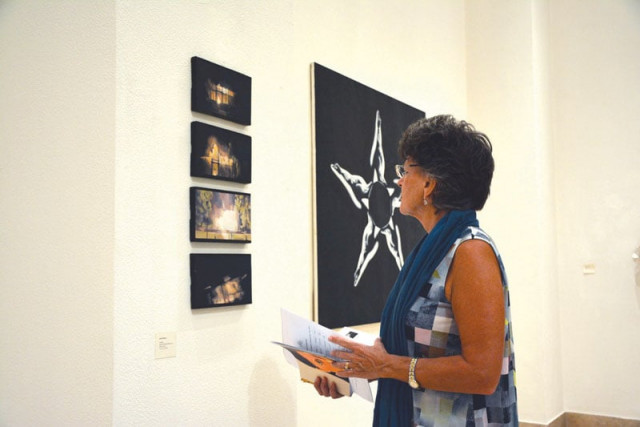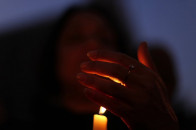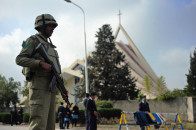Behind the paintings: Six artists display their worldview at Satrang Gallery
Curator says artists seek to convey identities influenced by history, society and culture.

An exhibition of six artists, titled “Through the looking glass”, opened up at the Satrang Gallery on Wednesday.
The exhibition revolves around the idea of portraiture and each of the artists has displayed a unique take on it. The ensemble is diverse as each artist explores the theme through their own medium and style.
“As this exhibition demonstrates, portraiture captures far more than the physical or even the emotional appearance of an individual. It seeks to preserve a state of being and convey an identity, influenced by history, society and culture,” said the gallery curator, Zahra Khan in a written statement.

Each artist explores the theme through their own medium and style. PHOTOS: HUMA CHOUDHARY/EXPRESS
Artist Sara Pagganwala’s work deals with a multidimensional display in mix media. Two of her pieces, which depict the contours of the female figure in geometric patterns sculptured out of paper, employing silver and gold leaf.
Pagganwala said her current work has evolved over time. “My work is very experimental and coming from a multidisclipnary arts background, I’m always trying out new ways to express myself,” she said. Pagganwala explores individuality and a sense of self through thought-provoking images and palpable structures.
Anem Zaidi’s portraits exude a lumunious quality, the skin tone and eyes emanating a realistic feel. In other pieces, her subjects are more subtle and subdued, leaving more to the imagination.
“The underlying theme of my work revolves around the power and resilience of a woman. Each face is unique both in forms and expresssions; what connects them all together is the single most meaningful quality that every individual ought to possess: courage,” she said.
Scheherzade Junejo extends the idea to anatomy and physical attributes. Her monochromatic paintings follow symmetry and order, while retaining a human element. According to the artist, her work is inspired by various aspects of dance, mime, yoga and theatre.
“My work began as an observation of human behavior through postures, movements and portions of anatomy. This exploration evolved into a study of polarity,” she said.
Cyra Ali’s canvas combines the ethnic essence of embroidery with modern acrylic paint techniques.
Faryal Ahsan’s collage captures accounts of acid and kerosene attack survivors. Her palette, though communicating morbid themes, uses a variation of toned-down colour to celebrate resilience.
Zahra Malkani uses her visuals to articulate protest and the circulation, proliferation and archiving of images in cybersapce as evidence and resistance in the Baloch and Sindhi nationalist movements. The oil-on-canvas portraits of missing persons seem like actual photos, blurred and manipulated in places. The exhibition will continue until October 17.
Published in The Express Tribune, September 18th, 2014.



















COMMENTS
Comments are moderated and generally will be posted if they are on-topic and not abusive.
For more information, please see our Comments FAQ